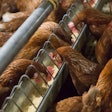
It’s been exactly one year since the presence of highly pathogenic avian influenza (HPAI) was confirmed in North America, leading to a outbreak of proportions none of us likely could have anticipated.
Nor is it likely that despite outstanding biosecurity efforts on behalf of the U.S. and Canadian poultry industries, the outbreak would be continual and last a minimum of one year.
The first confirmed case occurred in one of the most northeastern areas of the continent, and it spread not only southward via the Pacific Flyway, but also westward, transcending all North American Flyways.
As the virus spread, here are key dates and events related to the HPAI outbreak during the past year:
The early months
December 20, 2021 – The Canadian Food Inspection Agency (CFIA) announced that the virus had been confirmed at an exhibition farm in St. John’s, Newfoundland and Labrador.
January 9, 2022 – CFIA reports a second HPAI case in Newfoundland and Labrador, proving the first detection was no one-off
January 14 – The first 2022 case of HPAI in the United States, albeit in a wild bird, is confirmed. A highly pathogenic Eurasian H5 variant of avian influenza is discovered in a wild American widgeon.
January 18 – North Carolina becomes the second U.S. state to have a confirmed case, with this case involving a blue-wing teal in Hyde County.
February 1 – Nova Scotia becomes the second Canadian province to have a confirmed case, after a wild goose in the Grand Desert area of Halifax tests positive.
February 3 – The first case of HPAI in a North American commercial poultry flock is confirmed in a commercial turkey flock in western Nova Scotia.
February 9 – A commercial turkey operation in DuBois County, Indiana, becomes the first confirmed case of HPAI in a U.S. commercial flock during the outbreak. This is also the first case to be confirmed in the Mississippi Flyway.
February 14 – HPAI reaches commercial poultry in the second U.S. state, Kentucky. This is also the first case of the year in a commercial broiler flock in the continent.
February 23 – The first case of HPAI in commercial layer flock is confirmed in New Castle County, Delaware. It was also the first flock that involved more than 1 million birds to be affected by the virus.
March 2 – The World Organisation for Animal Health reports the first case of HPAI in the Pacific Flyway, after samples taken from a dead bald eagle in Vancouver, British Columbia, tested positive. The point of introduction appears to be different than the previous North American cases to the east.
March 6 – A commercial mixed flock in Charles Mix County, South Dakota, becomes the first confirmed HPAI case in the Central Flyway. With this case, the virus has now been located in all four North American flyways.
March 27 – Ontario becomes the second Canadian province to have HPAI confirmed in a commercial poultry flock.
April 19 – A commercial broiler breeder flock in Montrose County, Colorado, becomes the first U.S. commercial operation in the Pacific Flyway to be a confirmed case of HPAI during the outbreak.
April 20 – Federal and provincial wildlife agencies announce that with the presence of HPAI in a wild geese and a bald eagle in Manitoba, HPAI has been confirmed in every Canadian province. Those cases include a combination of commercial and backyard poultry, as well as wild birds.
April 27 -- To help ensure APHIS can continue to provide critical rapid response activities, U.S. Agriculture Secretary Tom Vilsack approved the transfer of nearly $263 million from the Commodity Credit Corporation to APHIS to directly support the response efforts.
An outbreak of highly pathogenic avian influenza (HPAI) hit a poultry breeder facility in the Mexican state of Coahuila, which borders on the U.S. state of Texas.
April 28 – The first human case of HPAI in the United States is announced by the U.S. Centers for Disease Control and Prevention (CDC). The patient was working as part of a crew that was depopulating an infected poultry flock.
May 5 – HPAI is confirmed in two red fox kits in Ontario, making it the first time the virus infected mammals in Canada.
Summer slowdown
June 2 – Jim Snee, CEO of Jennie-O Turkey Store parent company Hormel Foods, cautions that consumers can expect “large supply gaps” as a result of the HPAI outbreak.
June 28 – After a noticeable summer slowdown in HPAI cases in North America, the presence of HPAI in a commercial poultry flock in Quebec is confirmed. With this new case, it becomes official that the 2022 outbreak has outlasted the 2015 outbreak. The last case of 2015’s outbreak was confirmed on June 16.
July 14 – The first case of HPAI in U.S. commercial poultry in more than a month is confirmed in a turkey flock in Sanpete County, Utah. This is the first in a long string of cases in this county.
August 25 – As part of the USDA's emergency loan program, applications are open for Minnesota producers impacted by HPAI quarantines set by the Minnesota Board of Animal Health.
September 7 – Avian influenza was detected for the first time in an American cetacean on September 7 after the virus was confirmed in a bottlenose dolphin in Florida.
September 28 – American Farm Bureau Federation said to expect record turkey prices at retail during Thanksgiving as a result of the HPAI outbreak.
Re-emergence in the fall
October 20 – The World Organisation for Animal Health released a report, stating that a backyard flock that was affected by HPAI in September was the country’s first case where the virus was of the H5N4 serotype. All previous cases were of the H5N1 serotype.
November 16 – With the discovery of HPAI in a commercial broiler breeder operation in Tennessee, more than half of the U.S. states have now had at least one confirmed case in a commercial operation in 2022.
November 24 – The governments of Canada and Ontario are investing up to CA$1.5 million through the Canadian Agricultural Partnership to help eligible non-supply-managed poultry operations and related agri-businesses increase biosecurity efforts to reduce the spread of the highly pathogenic avian influenza.
December 1 – With the discovery of HPAI in an Abbotsford commercial poultry flock, British Columbia surpasses Alberta as the province with the most cases.
December 8 – Minnesota, the state with the most cases of HPAI in commercial poultry in 2022, has its 80th case confirmed.
December 14 – South Dakota, which trails only Minnesota for the number of avian influenza cases in 2022, has its 60th confirmed case.
December 16 – With the detection of HPAI in a layer flock in Weld County, Colorado, a minimum of 300 commercial flocks in the U.S. have been affected by the virus, involving about 55.9 million birds.
Read our ongoing coverage of the global avian influenza outbreak.



















